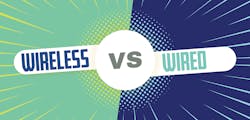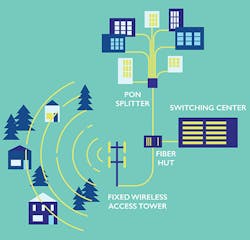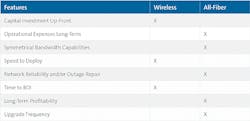Could Hybrid Fiber-Wireless Networks Be the Answer?
Normally pitched against each other as rivals, wireless networks have been under fire recently when compared to all-fiber architectures. There are distinct advantages and disadvantages for each to consider, however, a blend of technologies may be the best option to a cost-effective deployment. Rather than a Wired vs. Wireless debate, more network operators are beginning to explore where these technologies work in concert with each other in a hybrid architecture.
"Fiber builds are optimal in theory but insisting on a fiber-only solution can kill a project when the last 5%-10% of locations are extremely expensive to pass. Where the economics of a 100% fiber network do not work, such as rural or remote areas, you need to consider a fiber-wireless solution," says Michael Curri, Strategic Networks Group.
Undoubtedly, all-fiber networks’ performance is unmatched — but that doesn’t mean it is the best choice for every situation. When to employ a blended approach depends on a number of factors. Even wireless systems have become more fiber-rich with optical links running all the way to the wireless antenna. Perspectives may vary based on which type of company is making this decision as do the scenarios they may encounter. Is the company a wireline-based ISP, a WISP at its core, or a brand-new entrant into broadband?
Traditional Wireline Providers
Many providers deploying fiber networks have their roots in copper/coax networks. Over time some operators have branched into delivering mobile services as part of their bundled offering as well. Areas deemed impractical to be overbuilt with fiber alone may now be revisited as more tools are made available to operators. Excessive costs to traverse challenging terrain have left some areas in broadband deserts, while others have pushed fiber deeper into the network, moving electronics to the curb or node and relying on existing cabling to complete the run to the subscriber.
As these networks evolve to support higher speeds, consider these examples where wireless technologies could be implemented.
Microwave in the Feeder: Right-of-way issues or obstructions may exist that make it impractical to deploy fiber everywhere in the feeder network to a distribution area. Leveraging the high-capacity nature of point-to-point microwave technologies in the backhaul allows operators to reach pockets of subscribers that can then be economically served by fiber. The bandwidth capacity needed in the backhaul link dictates the type of microwave system used. (See Figure 2.)
Figure 2. Microwave point-to-point in the backhaul with fiber on either side.
Fixed Wireless Access as the Drop: Perhaps there is a scenario where fiber easily reaches deep into the network and to many homes/businesses, but restrictions or permitting issues limit the ability to bring fiber connections to every end-user location. Leveraging fixed wireless access points to provide service to a fraction of the otherwise fiber-fed subscribers is an alternative, provided line-of-sight to subscribers is achievable. Keep in mind, power must also be made available at the radio location to support the optical to wireless electronics. (See Figure 3.)
Figure 3. Fiber-fed neighborhood with a subset fed by FWA.
LTE Routers as the CPE: For operators that offer LTE services themselves or through partnerships, there may be an option to support connectivity through existing LTE coverage. Reliability could suffer and sluggish speeds may result if the system becomes overburdened with other wireless traffic on the tower. This may be leveraged as a stop-gap solution until construction of a fiber network or more bandwidth-intensive 5G FWA options are deployed.
Traditional Wireless Providers (WISPs)
WISPs leverage a mix of microwave and fiber signals to feed their active electronics in the field, whether that be on towers, rooftops, lamp posts, or even grain silos. In high-growth areas where subscriber density is on the rise, upgrading the wireless backhaul to fiber is very common and affords additional future upgrade options. Additionally, increasing demands for higher speeds from residential or business customers may exceed the capacity of the existing wireless network.
Some examples of how WISPs have leveraged fiber include:
Leveraging Spare Feeder: WISPs with fiber-fed towers or aggregation points looking to stretch their bandwidth offerings may run spurs off their fiber feeder network to support lucrative business parks or high-density residential subscribers directly with fiber. Depending upon the availability of dark fiber in their network, this might also present an option to be a backhaul provider for other network service providers.
Overbuilding With Fiber: Where take rates have risen and wireless spectrum becomes exhausted, operators have fully overbuilt select areas with all-fiber networks to free up spectrum to be used to acquire new wireless customers. This rewards existing subscribers with increased broadband speeds, and offers a better ROI with a known, paying subscriber base.
Equipment Refresh: As wireless equipment becomes outdated and the actives are scheduled for replacement, operators have evaluated the cost of new wireless gear versus the cost and OpEx savings of fiber networks which might be better suited to the service area. Situations also arise where new construction impedes previously clear line-of-sight and necessitates either new fiber-fed wireless sites to be constructed or simply a conversion to a fiber drop.
InvisiLight® Solution for Deploying Fiber
April 2, 2022Go to Market Faster. Speed up Network Deployment
April 2, 2022Episode 10: Fiber Optic Closure Specs Explained…
April 1, 2022Food for Thought from Our 2022 ICT Visionaries
April 1, 2022New Entrants
Moving quickly to deploy a network and generate cash flow is critical to many startups. Some operators have used a "wireless first" strategy to acquire customers quickly with intentions to later overbuild with an all-fiber network. This may on the surface seem wasteful and contrary to the "build once" approach but lowering the initial capital outlay to begin earning a positive ROI may outweigh the costs to rip and replace.
An added benefit is the wireless electronics and wireless ONTs used on the subscriber premises can be harvested and repurposed once the fiber network is lit and operational. With the race to support new subscriber growth, this has become more popular in recent months.
Common Threads
The reality is no matter which entity type is looking to build (Telco, CATV, WISPs, Munis, or REC), the factors being evaluated are often the same. Each entity needs to find the right balance for its business, as well as the consumers it aims to serve. If looked at in absolute terms, with a pure fiber vs. pure wireless network approach, it may be difficult to decide, because the factors individually may favor one system over the other.
Which factors lean toward wireless or all-fiber strategies are shown in Figure 1.
Figure 1. Factors that favor wireless or all-fiber strategies.
Still other factors are harder to decern — as an example, rights-of-way can be very problematic. Pole attachment agreements, access to local power, or tower lease fees, can be extremely expensive and slow to acquire, making it difficult to determine whether any network type has any distinct advantage. All pointing to why network and customer needs should be looked at holistically with an eye toward the reality of the competitive landscape as well.
For more information, please email [email protected] or visit www.corning.com/fttp.
Like this Article?
Subscribe to ISE magazine and start receiving your FREE monthly copy today!
About the Author








